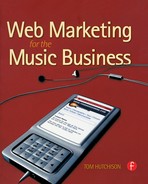CHAPTER 14
Mobile Media
The digital and mobile revolutions continue to present the entertainment industries with opportunities and challenges. Whereas the Internet and desktop computers have dominated the paradigm shift in the past, the future belongs to wireless mobile technology. Already, the growth of cell phone adoption outstrips Internet adoption. The basic mobile phone, which has been around for nearly 30 years, has evolved from a voice-only form of communication to a multimedia device capable not only of communication but of delivering information and entertainment. In 2008, The International Confederation of Authors and Composers Societies (CISAC) predicted that by 2010, half of all digital content would be delivered to mobile devices. A 2007 survey of 16- to 54-year-old cell phone users by Lodestar Universal found that although only 35% of mobile phone usage in the United States was for features other than voice phone service, over 75% of usage in Japan is for other services.
FROM CELL PHONE TO MOBILE COMMUNICATION DEVICE
The wireless handset, now morphing into a multimedia personal communication device, continues to grow in popularity around the world. Beginning with the third-generation (3G) handsets a few years ago, mobile data networks and increasingly sophisticated handsets have been providing users a variety of offerings. The first generation of mobile phones was introduced in the 1970s, and the period lasted through the 1980s. These devices worked on an analog signal much like those used by two-way radios. The second generation began in the 1990s, used digital voice encoding, and included the geographically compatible Global System for Mobile (GSM). The third generation, or 3G technology, allowed for enhanced multimedia, broad bandwidth and high speeds, and usability for a wide variety of communication tasks.
Mike Hanlon (2008) in GizMag reported that half of the global population has a cell phone. He stated that we have reached the tipping point in cell phone penetration. According to Hanlon, 1.12 billion phones were sold globally in 2007, up from a billion the previous year. The largest growth is coming from China and India, with many developing companies opting to bypass landlines in favor of setting up the less expensive wireless communication and avoiding the installation of a landline infrastructure.
Large slabs of Asia and the Pacific have been swept up in the coming of mobile telecoms in the last few years—in January 2004, only one in twenty Pakistanis had a mobile phone. By the end of 2008, better than one in two Pakistanis will own a mobile, taking sophisticated communications into many regions for the first time. The social changes must be immense.
The Pew Internet and American Life Project reported in early 2008 that over 75% of Americans use either a cell phone or a personal digital assistant (PDA). And 62% of all Americans have some experience with mobile access to digital data of some form, whether it is text messaging or music downloading. More Americans said it would be harder to give up their cell phone (51%) than the Internet (45%) or television (43%). In a breakdown by age group, older users were more inclined to say it would be hard to give up their landline telephone than their cell phone-unlike the 18–29 demographic, who would much rather give up a landline phone than their cell phone.
Mike Hanlon, GizMag
CONSUMER USAGE OF MOBILE COMMUNICATION DEVICES
The 3G handsets, which are now widely in use in parts of the globe, offer users a new data network with more bandwidth than the original analog and first-generation digital cellular phone service. The wireless data services continue to evolve. Marguerite Reardon (2008) wrote in CNET news, “The ink on the checks written to pay for mobile operator's 3G wireless networks is barely dry, and operators are already thinking of their next generation networks” (http://www.news.com/2102-1039_3-6229811.html). The Worldwide Interoperability for Microwave Access, or WiMAX platform, offers consumers the ability to utilize all the different types of wireless communication systems in the marketplace; in other words, it offers interoperability between different types of devices including cell phones, PDAs, and laptops. In 2008, Sprint Nextel committed to spending $5 billion on using the technology. The proposed network may cover up to two miles from one base station and deliver speeds of up to 12 Mbps. However, WiMAX faces competition from other standards, such as long term standard (LTE),1 that are entering the marketplace.
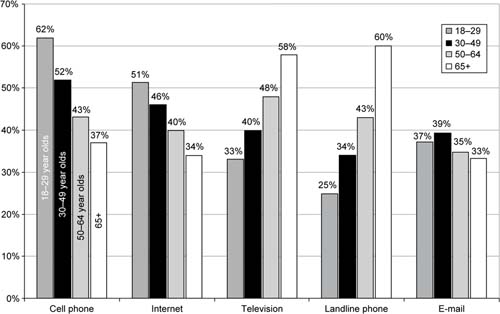
FIGURE 14.1 Consumer willingness to give up entertainment/communication technologies.
The Pew Internet and American Life Project (2008) has also reported that as of December 2007, 62% of Americans have had some experience with mobile access for activities other than voice communication, either through mobile phones or wireless laptops. The most popular alternate use for cell phones is text messaging, with 58% of cell phone users stating they have used their device for text messaging. Equally, 58% have used their cell phones to take a picture, whereas only 17% have used their handheld device to play music and only 10% to watch a video. Of interest to the Pew researchers, nonwhites, specifically African Americans and English-speaking Hispanics, were more likely to engage in media activities other than voice phone service than their white counterparts.
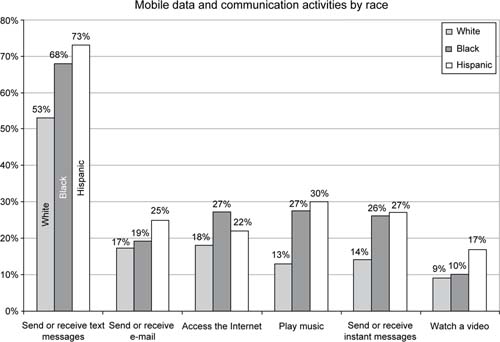
FIGURE 14.2 Mobile communications activities by ethnic background. (Source: Pew Internet and American Life.)
Mobile device usage also varies by age, with younger adults much more likely to use these devices for text messaging and all other nonvoice activities. In all categories, usage decreased with age, thus underscoring the vast generational differences that exist between a generation that has grown up around computers and an older generation whose computer experience is limited to adulthood. In her article, “Text Messaging on Rise with Young People,” Martha Irvine (2006) stated, “the former darling of high-tech communication [e-mail] is losing favor to instant and text messaging.” The article continued to say that young people see e-mail as a way to reach older people such as their parents, but are, themselves, increasingly using text messaging over e-mail as a means to stay in touch with each other. They associate e-mail with work, school, and spam.
With text messaging already in high gear for younger demographics, and mobile Internet access on the rise in the United States among young people, the United States is expected to catch up to Asia and Europe in Internet use via mobile handsets, offering marketers and musicians a chance to communicate with fans in innovative new ways.
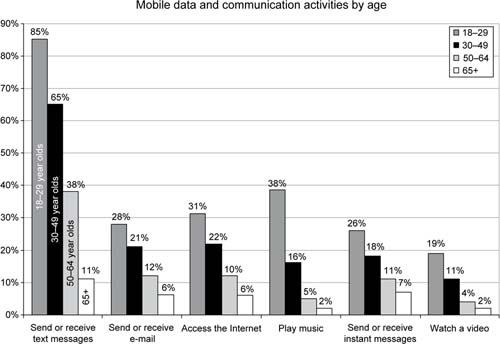
FIGURE 14.3 Use of mobile communications by age group. (Source: Pew Internet and American Life.)
On the m-commerce (mobile commerce) front, in a study by LodeStar Universal—which included the United Sates, Brazil, Russia, Pakistan, India, China, and Japan—e-commerce and financial transactions were touted as showing promise, with 81% of Japanese respondents claiming to have already used the services. In the United States, banks are beginning to offer banking services via cell phone, including checking on account balances, paying bills, and transferring funds, and concert promoters are beginning to use cell phones for ticket sales and delivery (see Chapter 15).
Are We There Yet?
In the article, “The Portable Web Still Has a Long Way to Go,” Michael Fitzgerald (2007) lamented the slow pace at which the mobile web business is developing, stating that only 13% of cell phone users in North America use the cell phone to surf the Web more than once a month. He stated that in 2000, the wireless application protocol (WAP) was supposed to bring Internet service to cell phone users, but that the adoption has been impeded by lack of high-speed networks and the high cost of services to the consumer. Caroline Gabriel, a Rethink Research analyst, said data made up only 12% of revenue per user in 2007, far below the 50% that was expected. In the “Geek” column (August 2006) in Internet Exposure LiveWire, the columnist stated, “three quarters of people are avoiding using mobile Internet because of the poor user experience and the high costs. (Chapter 15 will discuss ways to create a mobi web site that is more suitable for small handsets.)
Enid Burns (2008), in the article “U.S. Mobile Web Adoption Slow,” stated that “mobile Internet penetration is lower in the U.S. than many European countries.” Burns cited that an average of 29% of European Internet users access the Web on mobile devices, compared to 19% in the United States.
Noah Elkin vice president at iCrossing stated, “The cost of mobile Internet access … continues to be a serious impediment for many consumers, and currently it's simply too high for mass adoption” (Elkin, 2007). He also advocated for more web-friendly handheld devices such as the iPhone.
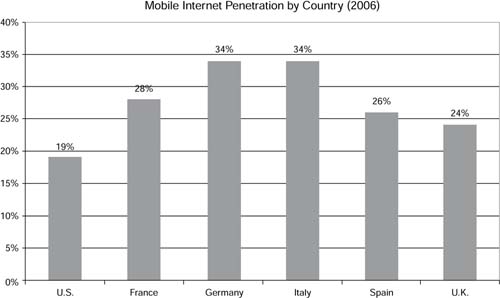
FIGURE 14.4 Mobile Internet penetration by country. (Source: ComScore.)
Yet by the end of 2007, Sarah Perez, in her article “Mobile Web Use Growing Faster Than Ever,” was optimistically stating, “mobile web access is a trend that is growing fast and will continue to grow” (Perez, 2008). She cited a 25% increase in monthly data transfer rate over the course of 2007, adding that the adoption of more sophisticated mobile devices, along with an improvement in customized content for mobile users, will facilitate further adoption of mobile web use.
The results of the Pew Internet and American Life project indicate that Americans have indeed become dependent on the use of mobile communication devices for activities other than voice phone, especially text messaging. That study and others have shown that mobile data and communication activities are especially important for user groups who do not also have landline Internet service, whether it's in developing countries who have bypassed landlines or demographic groups in the United States and other countries who had opted for wireless communication only and are less like to have ever adopted landline communications. The Pew study also indicates that mobile web adoption is still in the early stages among most demographic groups, with the 18 to 29 age group showing the most usage at 31% of cell phone users. This group is also the most inclined to be heavy users of social networking sites. As mobile Internet becomes more popular, marketers are looking at ways to provide popular content to this age group, and social networking looks very attractive.
MOBILE SOCIAL NETWORKING
In 2006, Business Week news analyst Olga Kharif reported that MySpace was creating a partnership with Cingular Wireless to bring MySpace to mobile customers. Already in 2006, 33% of young adults (18- to 24-year-olds) were posting photos to web sites via mobile phones. MMetrics analyst Mark Donovan said in 2006, “there's absolutely interest in participating in mobile social networks” (Karif 2006). Then in 2007, MMetrics reported that 12.3 million consumers in the United States and Western Europe reported accessing a social networking site with their mobile device in the month of June 2007. Kharif stated, “it's the cell phone, rather than the personal computer, that's the constant companion for today's hip and socially networked.”
The attraction for marketers is the 3.3 billion cell phone subscribers, which, according to Victoria Shannon of the New York Times (2008), is a number that far outweighs total Internet users. Kharif expects mobile customers to use social networking services when they are stuck somewhere outside the home, for example, waiting for public transportation.
Mobile social networks are attempting to exploit the geographic benefits of mobile social networking by providing location information of friends via global positioning information. This added dimension to social networking allows users to physically meet one another using mobile devices. The Web 2.0 site loopt.com touts its service as a social compass by automatically notifying users when their friends are physically nearby. This feature could be beneficial to concert goers who attempt to meet up with friends at a venue that may be filled with thousands of other fans (see Chapter 15 on cell phone usage at concerts).
As mobile phone users continue to find new ways to use phones for staying connected and for social networking functions, opportunities are developed to promote music, much the way computer-based social networking sites have found numerous ways to incorporate music into the social activities of their sites. Chapter 15 will explore ways to use mobile communication devices to promote music and music-related social events with the help of text-messaging, viral marketing, and mobile Internet features.
GLOSSARY
3G technology — The third generation of developments in wireless technology, especially mobile communications, that allows for the transmission of data and multimedia content.
Bandwidth — The amount of data that can be carried from one point to another in a given time period (usually a second).2
Global positioning (GPS) — A group of well-spaced satellites that orbit the Earth and make it possible for people with ground receivers to pinpoint their geographic location.
GSM — A digital cellular phone technology that is the predominant system in Europe but also used worldwide. GSM is the dominant second-generation digital mobile phone standard for most of the world. It determines the way in which mobile phones communicate with the land-based network of towers.
Iphone — A smartphone made by Apple that combines an iPod, a touch screen, a digital camera, and a cellular phone. The device includes Internet browsing and networking capabilities. The iPhone supports both WiFi and cellular connectivity, depending on which signal is available.
Landline phone — Refers to standard telephone and data communications systems that use in-ground and telephone pole cables in contrast to wireless cellular and satellite services.
Mobi — Internet domain used for web sites that supply content to cell phones and other handheld devices with tiny screens.
PDA — Personal digital assistant; a handheld device that may combine computing, telephone/fax, Internet, and networking features.
Social networking sites — Places on the Internet where people meet in cyberspace to chat, socialize, debate, and network.
Text messaging — Sending short text messages from a mobile phone to other mobile phone users.
WAP — Wireless application protocol is a specification for a set of communication protocols to standardize the way that wireless devices can be used for Internet access. A WAP browser provides all of the basic services of a computer-based web browser but is simplified to operate within the limitations of a mobile phone; for example, it has a smaller view screen.
Wi-MAX (Worldwide Interoperability for Microwave Access) — “Designed to extend local Wi-Fi networks across greater distances such as a campus, as well as to provide last mile connectivity to an ISP or other carrier many miles away. In addition, Mobile WiMAX offers a voice and higher-speed data alternative to the cellular networks” (answers.com/topic/wimax).
REFERENCES AND FURTHER READING
Burns, Enid. (2008, October 23). U.S. mobile web adoption slow, www.clickz.com/showPage.html?page=3623758.
Elkin, Noah. (2007, March 29). The path to mobile web adoption. iMedia, www.imediaconnection.com/content/14206.asp.
Fitzgerald, Michael. (2007, November 25). The portable Web still has a long way to go. International Herald Tribune. www.iht.com/articles/2007/11/25/technology/proto26.php.
Geek column. (2006, August). Dear Geek column. www.iexposure.com/live_wire/august06/dear-geek.cfm.
Hanlon, Mike. (2008). The tipping point: One in two humans now carries a mobile phone. GizMag. www.gizmag.com/mobile-phone-penetration/8831.
Irvine, Martha. (2006, July 18). Text messaging on rise with young people. www.foxnews.com/wires/2006Jul18/0,4670,SnailEmail,00.html.
Kharif, Olga. (2006, May 31). Social networking goes mobile. Business Week, www.businessweek.com/print/technology/content/may2006/tc20060530_170086.htm.
Mi2n. (Music IndustryNews Network). In 2010, half of all digital content will be delivered to mobile devices, www.mi2n.com/press.ph3?press_nb=106654.
Perez, Sarah. (2008, March 11). Mobile web use growing faster than ever. ReadWriteWeb, http://publications.mediapost.com/index.cfm?fuseaction=Articles.showArticle&art_aid=77840.
Pew Internet & American Life Project. (2008, March). Mobile access to data and information, www.pewinternet.org.
Reardon, Marguerite. (2008, February 12). The next big thing in wireless. CNET News, www.news.com/2102-1039_3-6229811.html.
Shannon, Victoria. (2008, March 6). Social networking moves to the cell phone. The New York Times. http://query.nytimes.com/gst/fullpage.html?res=9C03E1DE143BF935A35750C0A96E9C8B63.
Turakhia, Saurabh. (2007, November 1). The medium is the mobile phone. Hindustan Times. www.kiwanja.net/database/article/article_mobile_medium.pdf.
Walsh, Mark. (2008, March 5). Study: Cell phone passes land line as hardest to give up. Media Post Publications, http://publications.mediapost.com/index.cfm?fuseaction=Articles.showArticle&art_aid=77840.
1 LET is a new wireless standard expected to enable downlink/uplink peak data rates above 100 Mbps/50 Mbps.
2 Bandwidth only accounts for the time that it takes to get into or out of your connection and is really just a potential speed. Each communication device has it's own bandwidth based upon its transmission capabilities. The speed of any communication is limited by the device(s) that are communicating, sort of a lowest common denominator situation. Bandwidth also doesn't account for periodic bottlenecks anywhere in the system or extra “hops” that the signal may need to make through the Internet.
